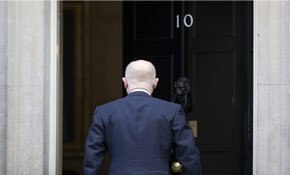John Humphrys asks, will David Cameron's reshuffle make a difference to the polls?
When prime ministers shake up their governments just ten months before a general election you can be pretty sure their chief concern is not so much what will make for better government but rather what will seem most appealing to voters. That, at least, is how many people are viewing David Cameron’s efforts this week. But can voters be seduced by what the practitioners call the ‘optics’ of politics? And even if they can, have the changes the Prime Minister has made to his government given his party the best chance of winning the election?
If you need any evidence to support the idea that appearance and image become more important than substance as elections approach, look no further than the fate of Michael Gove. Even his greatest enemies would not dispute the claim that the man who had been education secretary for the last four years and who was suddenly dumped on Tuesday morning was probably the most radical and effective reformer in the government. His policies of extending academies and introducing free schools, as well as his interventions on the curriculum and much else, have transformed the face of British schooling. And those reforms are likely to be lasting. Most commentators believe that even if there is a change of government next year, much of what Mr Gove has put in place will remain.
Yet he has gone. He had become, in the political language of the times, ‘toxic’. He had alienated large parts of the teaching profession, with hatred of him becoming more intense the closer one got to the ‘chalkface’ in the classrooms.
This perhaps might not have mattered too much in itself in that radical reformers always have to tread on corns and in this particular case the corns he trod on belonged in part to the teaching unions, hardly the most popular institutions in the country. But polling evidence had emerged that Mr Gove was upsetting parents as well. Not only did a majority of the population recognise who he was (an unusual phenomenon in modern politics) but more than half of voters thought he was doing a bad job. This gave an opening to opponents of the Conservative Party, not least their coalition allies, the Liberal Democrats, who had discovered that attacking Mr Gove was one of the best ways to rally their own flagging fortunes. So Mr Gove had to go, even though his successor, Nicky Morgan, is committed to continuing his policies. Her task is to do it more pleasantly.
That the reshuffle was motivated by the need to improve the Tories’ image rather than to change the government’s course was reflected in other moves the Prime Minister took. The Conservative Party’s electoral problem has been summed up by Yougov’s own Peter Kellner. He points out that a party whose leader is so much more highly regarded than either the party he leads or the Leader of the Opposition, and whose government is streets ahead of the opposition on the question of which party is most trusted to run the economy, ought itself to be streets ahead in the polls. Yet even though these two conditions apply, the Conservatives are broadly-speaking neck-and neck with Labour in the opinion polls, or trailing them. Given that the electoral system requires the Tories to be several points ahead of Labour to have any chance of winning a majority, this is alarming news for Mr Cameron.
Peter’s explanation for why this is so is clear. The problem is the Conservative’s Party’s image. It is seen as a party of rich, middle class white men, most of them southerners. They are therefore regarded as not representative of the British people as a whole, either in terms of class, region or sex. Most disturbingly for the party, women, who used to be counted on to favour the Tories over Labour, no longer do so.
So Mr Cameron concluded that he needed to change this image. The result was a culling of that very group -- middle class, white, male (often rich) ministers, irrespective of whether they had been doing a good job or not. The Prime Minister’s first aim was to make the government and his party look more female.
Some time ago he set himself the task of having a third of his ministers as women by 2015. It looks unlikely that he will achieve this. Tuesday’s reshuffle increased the number of women in the cabinet from three to six (and brought to an end what was regarded as the embarrassing fact that after Maria Miller’s resignation earlier this year, there was no mother in the Cabinet). The total number of women ministers has risen from 20 to 25, but this is still only about a quarter of all ministers, so short of his target.
But will this persuade voters to think differently about the Conservative Party? Few commentators doubt the abilities of the women he has chosen to promote, but sceptics argue that it is patronising to the very women voters to whom he is trying to appeal to suppose that they will be seduced simply by the fact that he has preferred women over men. It looks like too transparent and cynical a dodge, they say.
But the Prime Minister clearly hopes that the move will work osmotically: the more voters see women ministers talking on television or hear them being interviewed by the likes of me on radio, the less they will associate the Conservative Party with the old stereotype of a rich white man’s club and the more they will think the party has changed. He said of his new government: “I think it is a team that reflects modern Britain and it is by reflecting all of modern Britain that we will get the best for our country. I am proud of the fact that great talent has come through the Conservative ranks and we now see Conservative women occupying posts like home secretary, education secretary, agriculture secretary, development secretary – vital jobs with really good people doing those jobs to secure the future of this country.”
The other electoral threat Mr Cameron has sought to fend off is the one posed by UKIP. His reshuffle has strengthened the eurosceptic forces in his government. Philip Hammond, the new foreign secretary, replacing William Hague who is retiring at the next election to spend more time playing his piano (among other things), is already on the record as saying he’d be prepared to leave the European Union if we could not negotiate acceptable reform to our relationship with it. The Prime Minister has also sacked Dominic Grieve, the Attorney General, a staunch defender of Britain’s commitment to the European Convention on Human Rights which many Conservatives and much of the right-wing press would like Britain to leave.
What is clear from his reshuffle is that there is not the slightest hint that the Prime Minister believes his government needs to change direction in any way. Quite the contrary. He wants his party to be judged next year on its record and on its determination to continue on the same path. What he does want, though, is to change his party’s image. He wants it to seem more eurosceptic; less dominated by rich, white, middle class men (like him); more representative of “all of modern Britain” and especially of Britain’s women; and less toxic.
The next ten months will be spent trying to persuade us that this new image really is the true image of the modern Conservative Party. Will it work?










